Just finished a Steinway A. I took a lot of pictures during the process of rebuilding it. I think the before and after pictures are striking, since the original board was in such bad condition. The original graph shows, i think, a typical case of a Steinway Dead spot. The second graph shows that by making small changes to the scale and creating evenness, the dead spot is engineered out of it.
Shows a problem at 4 and 5. Length and volume curves dont match.
Silky Smooth. The dead spot is gone and the length and volume curves are parallel. Because these changes are subtle, visually there is not much change in appearance.
All Steinways that I have looked at exhibit this same problem area characteristic, Constriction.
His belly growls in hunger to what he sees.
But alas, the caveman tickles the ivories.
Original Message:
Sent: 04-12-2018 18:40
From: Chris Chernobieff
Subject: Rib height or width?
The only piano recordings I could find of marc allen sounded thin and glassy. I suspect poor recording equipment because of the room acoustics sounded bad.
I totally agree words only go so far when it comes to describing sound. I'm not advocating a muddy sound, nor an overpowering bass.
I also agree about charts with regard to string scales, but with rib scales they are more appropriate because of their structural nature.
I am looking forward to recording in the future.
Should be fun.
-chris
Original Message------
This is where we have to wait for a decent recording to see what various sounds you are valuing in your aesthetic actually sound like. For instance, in my book, the "roaring" of your BB, could possibly be, in my take on it, a "booming" sound...which I find highly objectionable. I remember a recording of a Marc Allen piano a couple of years ago, that had that booming bass. The description in the journal of how he achieved it was interesting. But...that booming bass was large and ungainly, and somewhat out of control...big, but out of control. I'm not saying this is the case, and perhaps for you "booming" means high fundamental which pulses one's solar plexus. Words are not helpful past a certain point, and I think we have progressed past this point.
Same with the "fat" sound. "fat" is what I refer to as an old Steinway structural inability to create a pitch focus, particularly in the tenor. Thick textures are indistinct and registration undifferentiated. I absolutely hate that sound, and take measures to make sure that my pianos never make this sound...hence my tendency to create a more controlled sound. Decisions are aesthetically driven. But once again, these are just words, and "fat" may mean something entirely different to the two of us...so I look forward to a sound sample, because I think you are making some interesting points.
Re the pretty graph lines, I have lost my affinity for these graphs, as I have seen wonderful sounding string scales that look like a saw-tooth that had ADD...all over the place. The lack of prettiness in the lines did not translate to experience of the sound, which was quite nice. That's not to say the lines are useless. But, I have gone through great trouble to create designs that looked smooth on paper, only to find that yeah...yadayada...it sounded like a piano, like all the other less beautifully smoothed designs.
I know you are working on the sound aspect, so I look forward to that bit of data.
.
------------------------------
Jim Ialeggio
grandpianosolutions.com
Shirley, MA
978 425-9026
Original Message:
Sent: 04-12-2018 13:34
From: Chris Chernobieff
Subject: Rib height or width?
***Long Post***
Well I did say "allows", not "only" LOL.
Comments are regularly made by many regarding problems exhibited by old boards. In this case the problem octaves in Steinways.
The cause, it seems to me, is blamed incorrectly on a method of construction, namely the hygroscopic compression crown. Thus the proposed solution is to replace that method with something else. That usually results in laminating ribs, adding more ribs, i-beam ribs, narrow and tall ribs, and uneven rib layouts. I think all of these plans just introduce other types of problems. Namely, and especially in Steinways, a different un-steinway sound. I like the description that it creates a thin sound (too much stiffness).
Players use to describe some Steinways and other by-gone pianos as having a fat sound.
My belief is that the root cause of the problems in compression crown boards has never been addressed. I am simply making an observation, based on analysis of numerous boards and constitutes as an opinion. I have seen some common traits such as: uneven rib transitions, incorrectly sized ribs for that location, poor rib volume distribution, wrong rib count, and as mentioned before, making the ribs narrow in the treble.
I am also collecting data that supports my case, for example:
I played and studied a REED and Sons Upright that was a 100 years old with a rib structure similar to what I am talking about.
It had a nice fat sound, was in fantastic condition with no cracks and good downbearing. I did not notice any problems in the treble such as dead spots. There were some false beats.
There were minor design flaws, but nothing horrible. Here's the data.
 Clearly suppose to be all 1" widths, but human imperfection as it is.
Clearly suppose to be all 1" widths, but human imperfection as it is.
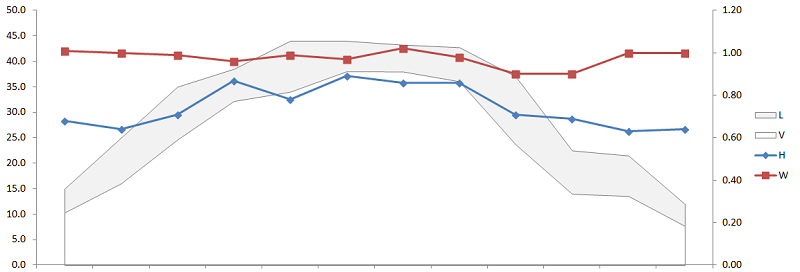
Length and Volume a bit out of proportion.
Height and widths uneven.

Section modulus and Delta curves uneven and rough.
For a fun exercise, here's how i would clean it up and make it more precise and efficient.
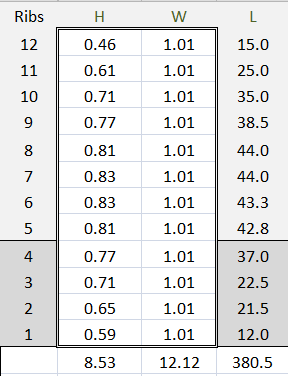

Section Modulus and delta curves silky smooth.
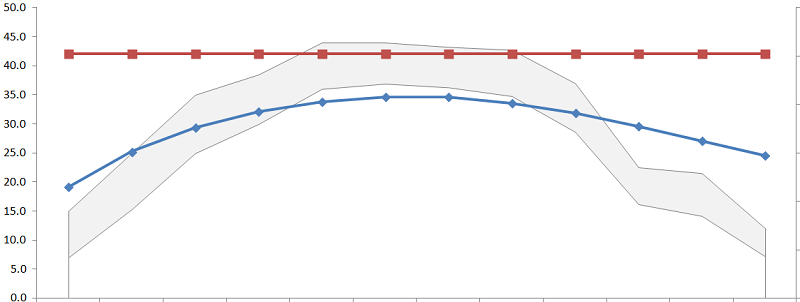
Length and volume curves in proportion
Height and width smooth and even.
-chris
------------------------------
A hunter's drumbeat steers the stampeding herd,
His belly growls in hunger to what he sees.
The mammoth aware blows his mighty trumpet,
But alas, the caveman tickles the ivories.
chernobieffpiano.com
865-986-7720
Original Message:
Sent: 04-12-2018 01:41
From: David Love
Subject: Rib height or width?
This isn't a board I built it's just an example of a smooth modulus that has variable rib widths. I've always aimed for a smooth modulus though there are other considerations that might impact how precisely smooth the curve is. I'd be happy to run a scale by you. Always interested in input. I'll get something together in the next few days.
------------------------------
David Love RPT
www.davidlovepianos.com
davidlovepianos@comcast.net
415 407 8320
Original Message:
Sent: 04-11-2018 10:55
From: David Love
Subject: Rib height or width?
OK I understand the derivation of section modulus but what do mean by "rib transition" and how are you calculating that. BTW here's a graph of a 17 rib board, section modulus, the widths, as you can see below, are not equal. (bass on the left)
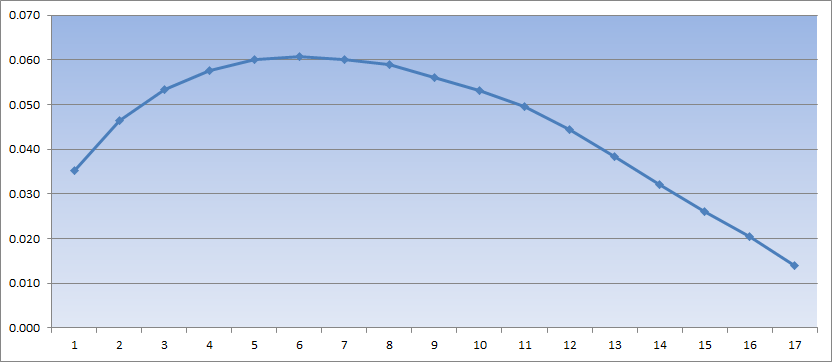
| Width |
|
| 22.0 |
| 23.0 |
| 24.0 |
| 24.0 |
| 24.0 |
| 24.0 |
| 24.0 |
| 23.0 |
| 23.0 |
| 23.0 |
| 22.0 |
| 22.0 |
| 21.0 |
| 20.0 |
| 19.5 |
| 19.0 |
| 18.5 |
------------------------------
David Love RPT
www.davidlovepianos.com
davidlovepianos@comcast.net
415 407 8320
Original Message:
Sent: 04-10-2018 10:51
From: Chris Chernobieff
Subject: Rib height or width?
**Long Post**
Ah, my favorite topic!
Installing a soundboard is very labor intensive. For too long, my normal procedure was to merely copy the original. Then came the Heintzman grand. After installation I did a standard tap test and was sorely disappointed. It just didn't have the liveliness that a new board should have. Thank goodness I recorded the info. The board had a 3/8"+ thick panel, and the ribs had what I now call a high profile (7/8" x 7/8") throughout. The result is an uneven section modulus and an uneven proportioning.
(Blue line is section modulus curve, red line is rib transition smoothness, treble on the left)
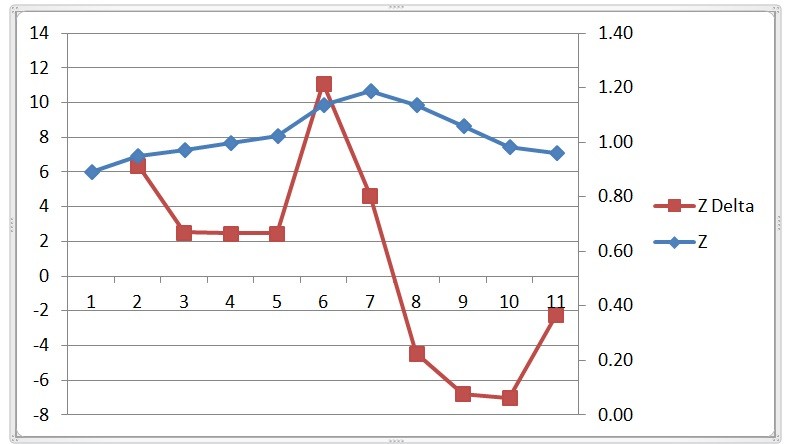
Thus, and so far, a three year research project began. I have been collecting soundboard data, listening to pianos, and observing rib scales and related problems etc etc. At first, one would naturally think that all ribs are the same and don't do much, therefore dimensions don't matter. But, just like string scales, there are many decisions to be made when it comes to a rib scale. Many different rib scale plans.
Steinway uses the plan of an 80%+ rib profile, 7 belly rail ribs ( the rest are spine ribs), with the top belly rail ribs getting smaller and narrower in an inconsistent fashion ( why widen the fields in the treble?). On the rare occasion when I come across a Steinway that sounds fuller and more alive than most others, the rib scale profile (so far) has been between 71% -76%. But they always have poor rib scale transitions.
Here's my latest rebuild a Steinway A pre 1900 original scale.
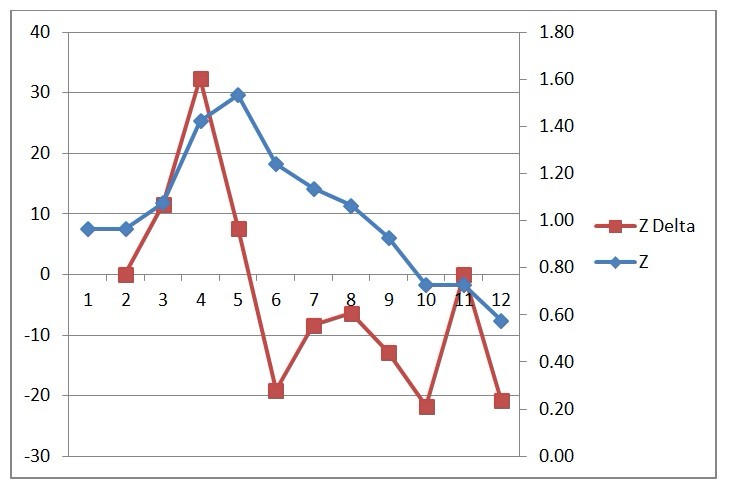
Now, when you have a rib scale this horrible, you need riblets, you'll have dead spots, etc etc. To answer Jim, my belief is that some ribs are worker harder than others, when they all should be working as a team.
For comparison, here is the Steinway A rib scale modified.
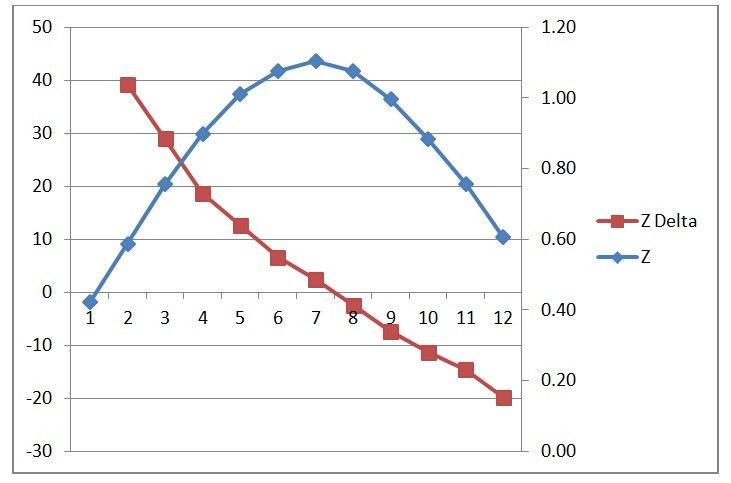
Silky Smooth.
This Steinway A went back to the Nashville technician, who has sworn to give me an honest feedback. Good or Bad. I am eagerly waiting.
Yes Jim (LOL) I will be producing recordings. I already have two professional pianists that will gladly perform, lined up.
Here are some fundamentals that I have settled on that give good and consistent results and deliver a sound quality that I like.
The rib count should equal the panel square feet. The sum of the width of the ribs should also equal the panel square feet.
Example:
12 square feet panel
12 ribs
Rib widths equal 12" ( Thus 1" wide ribs)
This does a few things. Creates evenness across the scale, provides smooth transitions, smooth section modulus curves. Allows for a 70% rib profile by adjusting heights and maintaining the section modulus TARGET. Allows for even and smooth Volume to length curves. Plus, it's simpler to deal with one parameter than juggle two.
A characteristic that I have noticed in the last few boards since adapting this method is a surprising carrying power. The piano seems to be more powerful the farther away you get from the piano. The Mason and Hamlin BB I recently did seemed to ROAR when I stepped across the room. I've heard many different pianos, never heard one do that, like that before. Certainly was motivating for me.
The ultimate goal of course was to come up with a product that impresses the clients, so the business will grow. Time will tell.
-chris
------------------------------
A hunter's drumbeat steers the stampeding herd,
His belly growls in hunger to what he sees.
The mammoth aware blows his mighty trumpet,
But alas, the caveman tickles the ivories.
chernobieffpiano.com
865-986-7720
Original Message:
Sent: 04-10-2018 01:39
From: David Love
Subject: Rib height or width?
Why is <1" a problem? Doesn't it matter the height, number of ribs in the section, width of the soumboard, rib material, to name just a few other factors? There's nothing magic about 1".
------------------------------
David Love RPT
www.davidlovepianos.com
davidlovepianos@comcast.net
415 407 8320
Original Message:
Sent: 04-09-2018 20:14
From: Karl Roeder
Subject: Rib height or width?
In another thread Mr Chernobieff wrote:
"On width, usually the top 5 treble ribs are too narrow, you can mic them yourself, anything less than 1.00" is a problem rib. "
First off, I use a caliper for this measurement and not even a good one as anything under a 64th of an inch is beyond my woodworking skills to duplicate. Why not leave the width the same and change the height? That way one doesn't have to change the notch in the inner rim. Mr. Chernobieff doesn't strike me as someone that does things haphazardly so I'm guessing he has a reason. Perhaps others will venture an opinion.
------------------------------
Karl Roeder
Pompano Beach FL
------------------------------